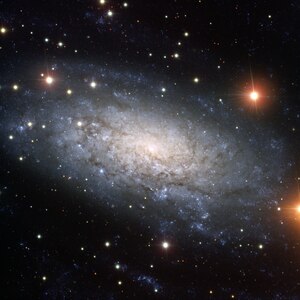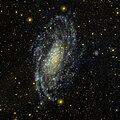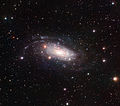NGC 3621
| Galaxie NGC 3621 | |
|---|---|
 | |
| Aufnahme vom Very Large Telescope | |
| AladinLite | |
| Sternbild | Wasserschlange |
| Position Äquinoktium: J2000.0, Epoche: J2000.0 | |
| Rektaszension | 11h 18m 16,5s [1] |
| Deklination | −32° 48′ 51″ [1] |
| Erscheinungsbild | |
| Morphologischer Typ | SA(s)d / HII[1] |
| Helligkeit (visuell) | 9,4 mag[2] |
| Helligkeit (B-Band) | 10,1 mag[2] |
| Winkelausdehnung | 12,3′ × 6,8′[2] |
| Positionswinkel | 159°[2] |
| Flächenhelligkeit | 14,1 mag/arcmin²[2] |
| Physikalische Daten | |
| Rotverschiebung | 0,002435 ± 0,000007[1] |
| Radialgeschwindigkeit | (730 ± 2) km/s[1] |
| Hubbledistanz H0 = 73 km/(s • Mpc) | (24 ± 2) · 106 Lj (7,26 ± 0,52) Mpc [1] |
| Durchmesser | 85.000 Lj |
| Geschichte | |
| Entdeckung | William Herschel |
| Entdeckungsdatum | 17. Februar 1790 |
| Katalogbezeichnungen | |
| NGC 3621 • UGC A 232 • PGC 34554 • ESO 377-37 • MCG -05-27-008 • IRAS 11159-3235 • 2MASX J11181630-3248453 • AM 1115-323 • GC 2371 • H I 241 • h 3337 • Dun 617 | |
NGC 3621 ist eine Spiralgalaxie vom Hubble-Typ SBcd im Sternbild Wasserschlange am Südsternhimmel. Die Galaxie ist schätzungsweise 24 Millionen Lichtjahre von der Milchstraße entfernt und hat einen Scheibendurchmesser von etwa 86.000 Lj.
Im Gegensatz zu den meisten anderen Spiralgalaxien verfügt das System nicht über einen zentralen Bulge, also über eine kugelförmige Ansammlung von alten Sternen. Die Galaxie gilt daher als reine Scheibengalaxie, auch Pure-Disc-Galaxie genannt.
Dennoch scheint es im Zentrum von NGC 3621 aber ein aktives supermassereiches Schwarzes Loch zu geben, was man eigentlich nur bei Galaxien mit einem solchen Bulge erwarten würde. Dieses ist aber relativ klein und dürfte eine Masse von rund 20.000 Sonnenmassen nicht überschreiten. Dafür gibt es allerdings, und dies ist eine weitere Besonderheit, noch zwei weitere Schwarze Löcher in der Zentralregion der Galaxie mit einigen Tausend Sonnenmassen.
In den Spiralarmen lassen sich zahlreiche helle Sternentstehungsgebiete mit jungen bläulichen Sternen erkennen. Auch sind die Arme von dichten Schwaden aus dunklem Staub durchzogen.[3][4]
Das Objekt wurde am 17. Februar 1790 von William Herschel entdeckt.[5]
- NGC 3621 im Infrarot, aufgenommen mit dem Spitzer-Weltraumteleskop
- Aufnahme der Ultraviolettstrahlung durch GALEX
- Mosaik hochaufgelöster Aufnahmen des Hubble-Weltraumteleskops
- Aufnahme mit dem Wide Field Imager (WFI) am 2,2-m-Teleskop La-Silla-Observatorium
Literatur
- König, Michael & Binnewies, Stefan (2019): Bildatlas der Galaxien: Die Astrophysik hinter den Astrofotografien, Stuttgart: Kosmos, S. 70
Weblinks
- SIMBAD Astronomical Database
- A special spiral galaxy for over 200 000 Facebook fans (engl.)
- GoBlack
- Altilhue - Chile
- Capella Observatory
- NGC 3621: Far Beyond the Local Group – Astronomy Picture of the Day vom 5. Juni 2002 (englisch).
- http://www.eso.org/public/usa/videos/eso1104a/ (Zoom auf NGC 3621)
- ESO: NGC 3621, eine malerische Scheibengalaxie (+Fotos, Karte & Animation) 2. Februar 2011
- ESO: Eine Galaxie voller Überraschungen – NGC 3621 hat keine Ausbuchtung, dafür aber drei zentrale Schwarze Löcher
- astronews.com: Bild des Tages 29. November 2011
- astronews.com: Bild des Tages 14. Oktober 2013
Einzelnachweise
Auf dieser Seite verwendete Medien
Autor/Urheber: Fabian RRRR, Lizenz: CC BY-SA 3.0
Color rendering is done by by Aladin-software (2000A&AS..143...33B.)
NGC 3621 galaxy by GALEX
Autor/Urheber: ESO, Lizenz: CC BY 3.0
This image, from ESO’s Very Large Telescope (VLT), shows a truly remarkable galaxy known as NGC 3621. To begin with, it is a pure-disc galaxy. Like other spirals, it has a flat disc permeated by dark lanes of material and with prominent spiral arms where young stars are forming in clusters (the blue dots seen in the image). But while most spiral galaxies have a central bulge — a large group of old stars packed in a compact, spheroidal region — NGC 3621 doesn’t. In this image, it is clear that there is simply a brightening to the centre, but no actual bulge like the one in NGC 6744 (eso1118), for example.
NGC 3621 is also interesting as it is believed to have an active supermassive black hole at its centre that is engulfing matter and producing radiation. This is somewhat unusual because most of these so-called active galactic nuclei exist in galaxies with prominent bulges. In this particular case, the supermassive black hole is thought to have a relatively small mass, of around 20 000 times that of the Sun.
Another interesting feature is that there are also thought to be two smaller black holes, with masses of a few thousand times that of the Sun, near the nucleus of the galaxy. Therefore, NGC 3621 is an extremely interesting object which, despite not having a central bulge, has a system of three black holes in its central region.
This galaxy is located in the constellation of Hydra (The Sea Snake) and can be seen with a moderate-sized telescope. This image, taken using B, V, and I filters with the FORS1 instrument on the powerful VLT, shows striking detail in this odd object and also reveals a multitude of background galaxies. A number of bright foreground stars that belong to our own Milky Way are also visible.Autor/Urheber: ESO and Joe DePasquale, Lizenz: CC BY 4.0
This picture of the spiral galaxy NGC 3621 was taken using the Wide Field Imager (WFI) at ESO’s La Silla Observatory in Chile. NGC 3621 is about 22 million light-years away in the constellation of Hydra (The Sea Snake). It is comparatively bright and can be well seen in moderate-sized telescopes. The data from the Wide Field Imager on the MPG/ESO 2.2-metre telescope at ESO’s La Silla Observatory in Chile used to make this image were selected from the ESO archive by Joe DePasquale as part of the Hidden Treasures competition.
NGC 3621








